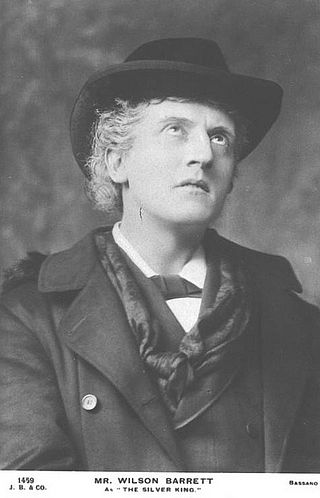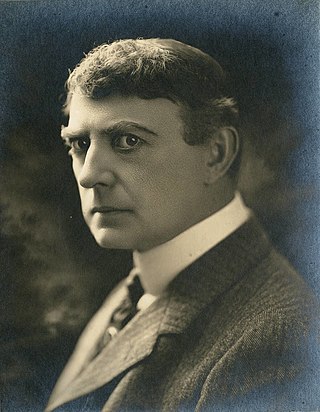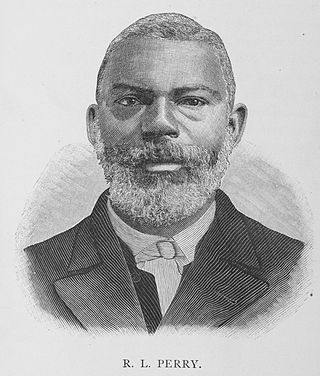
The Tragedy of Othello, the Moor of Venice, often shortened to Othello, is a tragedy written by William Shakespeare around 1603. Set in Venice and Cyprus, the play depicts the Moorish military commander Othello as he is manipulated by his ensign, Iago, into suspecting his wife Desdemona of infidelity. Othello is widely considered one of Shakespeare's greatest works and is usually classified among his major tragedies alongside Macbeth, King Lear, and Hamlet. Unpublished in the author's life, the play survives in one quarto edition from 1622 and in the First Folio.

Wilson Barrett was an English manager, actor, and playwright. With his company, Barrett is credited with attracting the largest crowds of English theatregoers ever because of his success with melodrama, an instance being his production of The Silver King (1882) at the Princess's Theatre of London. The historical tragedy The Sign of the Cross (1895) was Barrett's most successful play, both in England and in the United States.

Edmund Kean was a British Shakespearean actor, who performed, among other places, in London, Belfast, New York, Quebec, and Paris. He was known for his short stature, tumultuous personal life, and controversial divorce.

Edwin Thomas Booth was an American stage actor and theatrical manager who toured throughout the United States and the major capitals of Europe, performing Shakespearean plays. In 1869, he founded Booth's Theatre in New York. He is considered by many to be the greatest American actor of the 19th century. However, his achievements are often overshadowed by his relationship with his younger brother, actor John Wilkes Booth, who assassinated the 16th president of the United States, Abraham Lincoln.

Lawrence Patrick Barrett was an American stage actor.

Edwin Adams was an American stage actor, considered to have been one of America's best light comedians.

Henrietta Vinton Davis was an elocutionist, dramatist, and impersonator. In addition to being "the premier actress of all nineteenth-century black performers on the dramatic stage", Davis was proclaimed by Marcus Garvey to be the "greatest woman of the Negro race today".

James O'Neill was an Irish-American theatre actor. He was the father of American playwright Eugene O'Neill and the inspiration for one of the primary characters in his son's play Long Day's Journey into Night.

Ira Frederick Aldridge was an American-born British actor, playwright, and theatre manager, known for his portrayal of Shakespearean characters. James Hewlett and Aldridge are regarded as the first Black American tragedians.

The African GroveTheatre opened in New York City in 1821. It was founded and operated by William Alexander Brown, a free black man from the West Indies. It opened six years before the final abolition of slavery in New York state. The African Grove Theatre was attended by "all types of black New Yorkers -- free and slave, middle-class and working-class" along with others. It was the first place where Ira Aldridge, who would later become an esteemed and renowned Shakespearian actor, first saw a production of a Shakespeare play.

William J. Simmons was an American Baptist pastor, educator, author, and activist. He was a former enslaved person who became the second president of Simmons College of Kentucky (1880–1890), for whom the school was later named.

Charles Warner was an English stage actor whose career of over forty years spanned the Victorian and Edwardian eras. Warner performed in a variety of styles, from Shakespeare's plays to comedies, but he was best known for his dramatic roles and the emotional intensity of his performances. His most famous character was the alcoholic 'Coupeau' in Charles Reade's melodrama Drink, a part that the actor performed many times during his career. Warner performed in the principal theatres in London during the period 1864 to 1887. He had a successful tour of Australia and New Zealand from December 1887 to June 1890, after which he returned to England. In 1906 Warner travelled to New York where he appeared on stage in several productions. In February 1909 he committed suicide in his Manhattan hotel room.

Othello is the titular protagonist in Shakespeare's Othello. The character's origin is traced to the tale "Un Capitano Moro" in Gli Hecatommithi by Giovanni Battista Giraldi Cinthio. There, he is simply referred to as the Moor.

Booth's Theatre was a theatre in New York built by actor Edwin Booth. Located on the southeast corner of 23rd Street and Sixth Avenue, Booth's Theatre opened on February 3, 1869.

William Creswick was an English actor. A popular tragedian on the London stage, he appeared with many leading actors of his day, including William Charles Macready, Edwin Booth and Fanny Kemble and was well known for his Shakespearean and melodrama roles in Britain, the U.S. and Australia.

Robert Bruce Mantell was a Scottish-born stage actor who made several silent films. He used the name Robert Hudson early in his career, as his mother objected to her son becoming an actor.

Paul Harris was an American actor. He had roles in films such as All Night Long, Across 110th Street, The Slams, and Truck Turner.

Jeremiah A. Brown was a politician and civil rights activist in the American city of Cleveland, Ohio. Early in his life, Brown worked on steamboats with Mark Twain. He later moved to Cleveland, where he was elected to the Ohio House of Representatives in 1885 where together with Benjamin W. Arnett, he played an important role in fighting black laws, supporting education, and working for the civil rights of Ohio's African Americans. He also held numerous state and national political appointments.

William Henry Steward was a civil rights activist from Louisville, Kentucky. In February 1876, he was appointed the first black letter carrier in Kentucky. He was the leading layman of the General Association of Negro Baptists in Kentucky and played a key role in the founding of Simmons College of Kentucky by the group in 1879. He continued to play an important role in the college during his life. He was also co-founder of the American Baptist, a journal associated with the group, and Steward went on to be the journal's editor. He was a leader in Louisville civic and public life, and played a role in extending educational opportunities in the city to black children. In 1897, his political associations led to his appointment as judge of registration and election for the Fifteenth Precinct of the Ninth Ward, overseeing voter registration for the election. This was the first appointment of an African American to such a position in Kentucky. He was elected president of the Afro-American Press Association in the 1890s He was a close associate of Booker T. Washington, and in the late 1890s and early 1900s, Steward was a prominent member of the National Afro-American Council, which was dominated by Washington. He was president of the council from 1904 to 1905. He was a lifelong opponent of segregation and was frequently involved in anti-Jim Crow law activities. In 1914 he helped found a Louisville branch of the National Association for the Advancement of Colored People (NAACP), which he left in 1920 to become a key player in the Commission on Interracial Cooperation (CIC). He was also a prominent freemason and twice elected Worshipful Master of the Grand Lodge of Kentucky.

Rufus L. Perry was an American educator, journalist, and Baptist minister from Brooklyn, New York. He was a prominent member of the African Civilization Society and was a co-founder of the Howard Colored Orphan Asylum, which developed from it. He was the editor of numerous newspapers and journals, most notably the National Monitor. He was a prominent Baptist, and in 1886 he founded the Messiah Baptist Church, where he was pastor until his death. He was also a classical scholar. He protested segregation at William E. Sinn's Park Theatre in New York City.





















